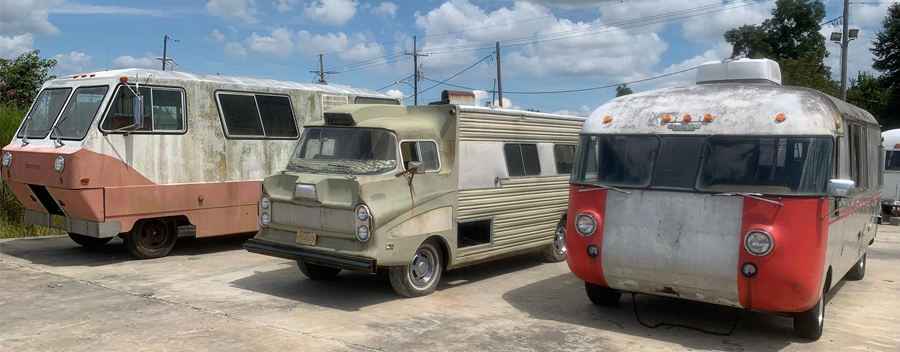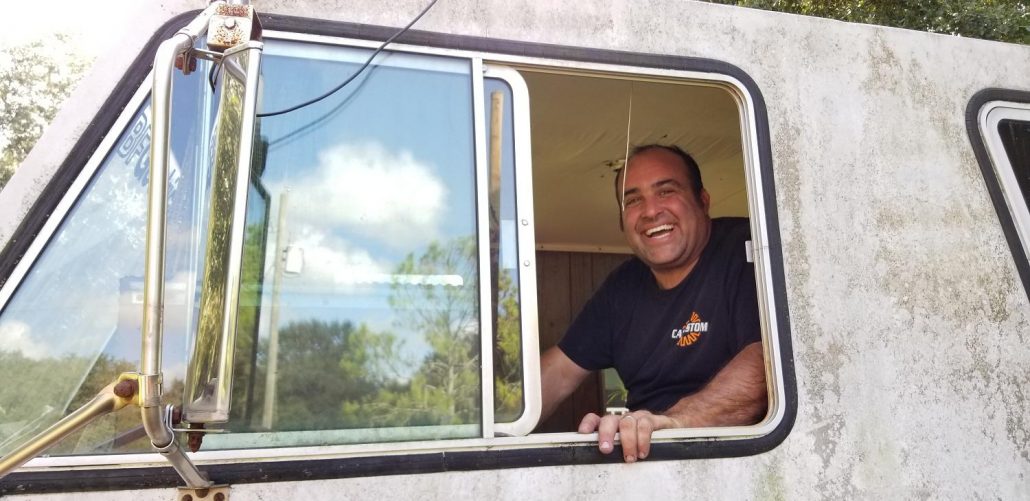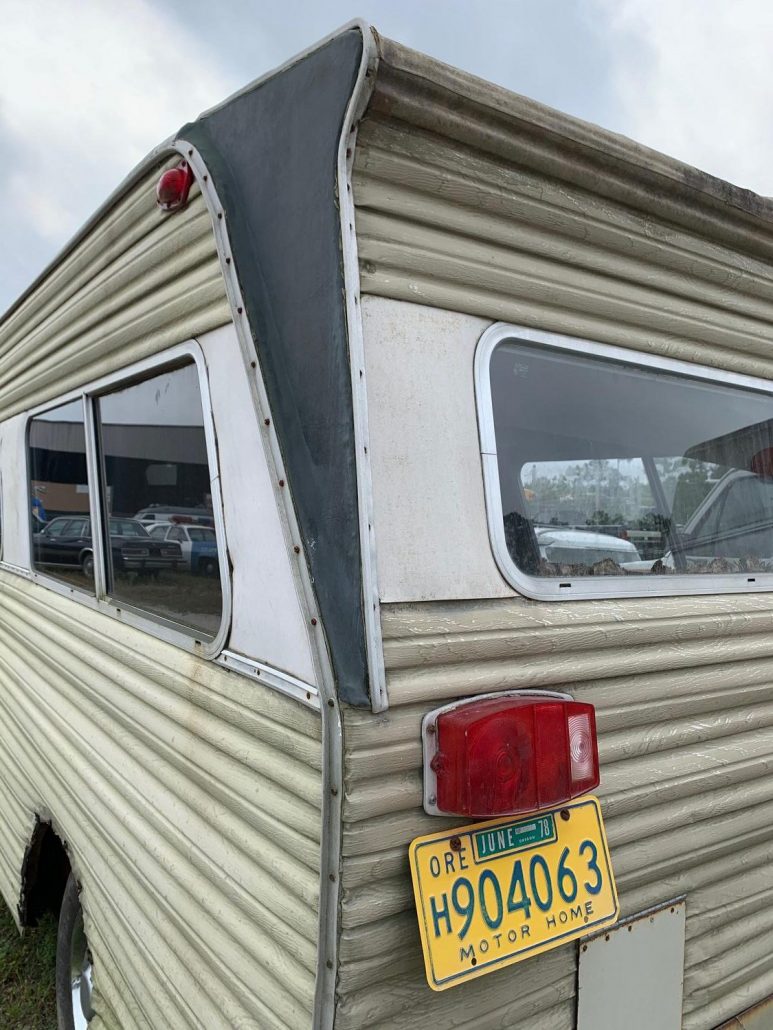
Richard Brown’s Rare RV’s: From Left to Right: The Ferber, the Marantette and his Ultravan
Hi Gang…
Richard Brown and I like unusual and rare RV’s. It’s not a big community that likes these vehicles. In fact, I think it might just be Richard and myself. Here’s a photo of Richard’s favorite RVs in his collection:
Richard’s collection beats me by “1” – I just have two rare RV’s shown below.

Geoff Hacker’s Rare RV’s: From Left to Right: The 1976 Bucci “Executive” and the 1971 Ferber “R” (stands for “Racing” *wink)
Of course we both like other vehicles too and you’ll find out (and I think be impressed) with Richard’s collection of one-off Barris custom vehicles in future stories – many of which should be new to most of you. Today’s story is about the RV that is in the center of Richard’s collection above – the “Marantette”. Let’s turn it over to Richard and learn more about his special RV. Take it away Richard 🙂
The 1966 Marantette “Feather Coach”
By Richard Brown
If motorhome design had a folk art category, that’s where you would find the Marantette “Feather Coach”. Its artist being Lou Marantette of Portland, Oregon. Lou was a creator of several various campers in the 50’s-60’s, but mostly notably, the one that is the subject of our conversation today. But first, a little back story on the man behind this unorthodox roaming chariot.
Born in 1921, Lou was one of four sons, all to achieve degrees in engineering. His brother Bill, even invented some computer circuit boards for NASA, that went to the moon. Lou was also an inventor, and holder of many patents. For many years, he was a mechanical engineer for the company General Metal Craft.
One notable achievement for Lou was the design and build of a hydraulic operated metal elbow former. A sheet of galvanized steel would be fed into it. The machine would cut it into sections, bend and roll it, attach the pieces, and spit out a heating duct elbow. His design and machines are still being utilized today. Coming from a profession that dealt in sheet metal fabrication, Lou started to create some things for himself.
 Having a family, and being a bit of an adventurer, Lou wanted to go camping. In the early 50’s, his first creation was a “canned ham” style camper, which he pulled behind the 1952 Ford family station wagon. Unlike other typical “tag-a-long” campers, this one was solid mounted to the car, making it one piece, unsegmented and the axle swiveled underneath on turns.
Having a family, and being a bit of an adventurer, Lou wanted to go camping. In the early 50’s, his first creation was a “canned ham” style camper, which he pulled behind the 1952 Ford family station wagon. Unlike other typical “tag-a-long” campers, this one was solid mounted to the car, making it one piece, unsegmented and the axle swiveled underneath on turns.
It proved successful, but he soon realized that this meant leaving the boat behind. For that, his next creation was a Homebuilt Class C Motorhome. Utilizing a 1953 Lincoln sedan, Lou cut the back half of the roof and trunk out, and fabricated a “cab-over” style camper section to the back.
Then soon after, something remarkable happened that brings us to the main focus of the story. The new 1960 Corvair came out, and our man Lou was inspired. Being an instant fan of the Corvair’s platform and drivetrain, he chose this as the basis for his new project. This time, the plan was to build an entire motorhome, from stem to stern. When a second-hand 1961 Corvair Greenbriar truck became available, Lou purchased it, and studied it immensely. He started making sketches, and building a scaled down 3D model of his own design. Shortly after, he went to work.
Lou laid out the Corvair drivetrain members, then built a birdcage type frame around it, from 1” square tubing to create the shape. Ultimately, the new coach would be wrapped in conventional sheet metal, but Lou wanted something different for the front cockpit area. Out of wood, plaster, and sections of Corvair body sheetmetal, he created a mock front end. From that “plug”, he built the mold that would produce this new fiberglass front nose.
To say this front end had character is an understatement. It had Corvair headlights turned on their sides. A center trapezoid light below the windshield that put out a soft glow. A functional ram-air scoop on the roof, for ventilation. The sides sported “coves”, similar to those found on a 1956 Corvette except in the opposite direction. The wraparound windshield is still identified but worked well.
 And to top it off, little sculpted fins protrude forward just above the headlight bezels. Phew…..it’s quite busy, with this mixed bag of design characteristics, but with its proportions, arrangement, and placement, it actually kinda works. The body was clad in textured ribbed aluminum sheeting, similar to other motorhomes of the era. Windows were extruded aluminum framed, sliding units.
And to top it off, little sculpted fins protrude forward just above the headlight bezels. Phew…..it’s quite busy, with this mixed bag of design characteristics, but with its proportions, arrangement, and placement, it actually kinda works. The body was clad in textured ribbed aluminum sheeting, similar to other motorhomes of the era. Windows were extruded aluminum framed, sliding units.
The coach’s only door for entry was a large double glass sliding door, on the right side of the body. Air scoops on the sides of the body routed the welcoming cool breeze to the Corvair air-cooled 6 cylinder engine, behind the rear axle. It’s overall length was 18.6 ft long, with an 11 ft wheelbase. Proudly painted red, Lou’s new prototype motorhome was completed in 1966. Like his other inventions and tool designs, it was patented and christened the “Feather Coach”. It was nimble, lightweight and quite different from the other behemoth motorhomes of the time.
Plans of putting these into production for the public was in the forefront of Lou’s mind. But like anything, it needed to be tested first. In 1967, Lou loaded up the wife, and 4 kids, and went on a summer vacation around the perimeter of the United States.
This several thousand mile trip really put the Feather Coach to the test. It successfully made the trip, yet Lou learned from it things he could better improve on. One issue was the power from the 110hp motor. Having experience myself with a 1968 Ultravan, (another motorhome sharing the same 110hp Corvair drivetrain), I can attest to the struggle of climbing hills being fully overloaded.
Never being able to sit still, Lou started working on a second “Feather Coach” prototype. Since this one was going to fix all the power problems of the first one, a big American V8 was chosen as the new power plant.
A pink 1957 Cadillac was the donor drivetrain for Coach #2. The problem was, that the original coach design only allowed for the motor to be placed in the rear. The size and layout of the front fiberglass cab, didn’t allow room for a large Cadillac motor, which is naturally housed in the front. Lou had a solution… Let’s make it mid engine! And that’s exactly what he did.
Extensively altering the Cadillac frame, the 365ci V8 was placed behind the front axle, hidden inside a kitchen cabinet built over it. The motor was now directly under the kitchen sink, with access via a cabinet door underneath. The bedroom was in the back with bathroom and shower left of the motor and behind driver seat.
Completed in 1971, it looked practically identical to the first one. This fresh new decade ushered in many different fashionable, hip colors. It was painted Avocado green, with walnut wood grain in the cove, and accented side panels. Different greens and golds decorated the inside interior.
The Cadillac V8 proved to be very robust, and was night and day compared to the Corvair V6. After a few local camping trips, a new problem was discovered which was adequately cooling this big V8. Hidden in the middle of the coach, airflow to the radiator was nil. A second radiator was added to the roof, and seemed to be a sufficient fix while the coach was in motion.
By now, the “Feather Coach” project was at the 10 year mark, and the pursuit to put them into production had subsided. Only two prototypes were ever built. The red Coach #1, which was sold off to Lou’s older brother Jim in the 70’s, and the green Coach #2 that left sometime in the late 80’s. The family remembers ole uncle Jim driving the red coach for many years after. Reportedly clocking nearly 200k miles!!
Jim ultimately sold the red coach, and it’s whereabouts are still unknown. The green Cadillac Feather Coach was lost for nearly 30 years until it appeared on a Portland Craigslist ad in 2017. The coach faired rather we’ll. It was all still intact, and had one remaining Cadillac hubcap. The Avocado green paint had faded, and the wood grain decals were bleached white from years of sun. With about a day of work, it might just run again!
 After its purchase, the seller later called with some great news. “Hey, the family of that old motorhome saw the ad, and they want to talk to you”. Well that was good news. Turns out, Lou’s sons were tipped off that Dads old motorhome survived. After many phone calls, emails, and photos, a friendship was made, and a definitive timeline on the Feather Coach was documented.
After its purchase, the seller later called with some great news. “Hey, the family of that old motorhome saw the ad, and they want to talk to you”. Well that was good news. Turns out, Lou’s sons were tipped off that Dads old motorhome survived. After many phone calls, emails, and photos, a friendship was made, and a definitive timeline on the Feather Coach was documented.
 Some assurance that the green coach will be saved and restored made the Marantette family quite happy. Lou passed away in December, 2003, but his legacy certainly lives on with friends and family who loved him. Much thanks to sons Brian and Tom Marantette for the interesting story, and all the photos.
Some assurance that the green coach will be saved and restored made the Marantette family quite happy. Lou passed away in December, 2003, but his legacy certainly lives on with friends and family who loved him. Much thanks to sons Brian and Tom Marantette for the interesting story, and all the photos.
Now…who’s going to find the red Feather Coach #1 ?
Summary:
Great thanks to Richard Brown for sharing the story about another handbuilt vehicle – not a sports or custom car this time, but a vehicle who’s story is central to a family and its history. Great job Richard and excellent article 🙂

Richard Brown in his newly acquired Ferber RV in 2018 – picking it up at our Fiberglass Farm Facility (even though its built from 1/8 plate aluminum). More stories on both my Ferber and his in future stories.
Richard has promised to share more stories with us – not just on the restoration of this car but many other of his adventures, acquisitions and more. You can see all of Richard Brown’s stories here on Undiscovered Class by clicking on the following link:
Click here to view the Richard Brown article archive
Hope you enjoyed the story, and remember…
The adventure continues here at Undiscovered Classics.
Geoff










I have found the green one, it is currently sitting in new orleans in front of lafayette cemetery 2, amc is filming something here and had this rv placed in front. The inside is in bad shape the outside looks rough, i hope they dont scrap it
What a great creation! Would be cool to see some interior pictures, especially the engine & cover–
Jeff Bibik
Yo Jeff…Thanks for again finding another interesting story to share. I come across from Hemmings and I always appreciate your finds and the backstory. Kevin
Sorry I misspelled your name…too early in the morning before Caffeine.
Great story, keep them coming!
Geoff, thank you for sharing the history of the “Feather Couch”. I am One Of Lou’s three daughters,Nancy. It was such a privilege to have such a creative and adventurous dad! He made life so much fun!!!?. I learned to water ski by the time I was five and cherished all the weekends boating and camping sharing memories with family!
I was givens the honor of making all the window treatments for dads creations, including the Hammock that mounted over the stove, loved the challenge!
Please ask Tom and Brian about the pontoon boat, I think we have pictures. It was made from oil drums, a Jeep engine, wood platform surrounded by a fence. “The original party boat”?
New owners painted it metallic silver, so fun!
Nancy, so glad you enjoyed the article. I wish I could have met your dad. He’s of the same cloth that my heroes are made. You can tell a lot about a man by the creations. When I saw the craftsmanship that went into the motorhome he built, I knew he was someone special. Then when I met your brothers, Brian and Tom, they confirmed it. Thanks for sharing some of your experiences. It adds to the story!
The Cadillac shown is a 1958, I had over a dozen, the Superior hearse interior had been converted to a camper, which worked quite well. For many years, a motorhome that looked (and sounded) like an Ultravan was in the Chico, CA area
Geoff, Thank you so much for posting this article about my beloved Grandfather!! It’s so fun to see the pictures and read the article. My Grandpa was the greatest and possibly one of the most humble and kind men to exist so it’s so fun to see his legacy get out into the world! Thanks again and take care.
Best,
Todd Albertini
Hey Todd, so happy you enjoyed the article. I felt it was an honor to write about your grandfather. He seemed to bring joy to everyone that knew him. Now a slice of the automotive world gets to experience a part of your grandfathers life, as well.
All Corvair engines were of the “boxer” configuration, not V shaped. all were air cooled, and one was turbo charged.
I don’t quite understand the comment made that all Corvair engines were flat engines, not V configuration. Went back to the article & it doesn’t mention the Corvair engine configuration at all. He later introduced aV8 engine into the design, but that was a Cadillac engine.
“The Cadillac V8 proved to be very robust, and was night and day compared to the Corvair V6. After a few local camping trips, a new problem was discovered which was adequately cooling this big V8. Hidden in the middle of the coach, airflow to the radiator was nil. A second radiator was added to the roof, and seemed to be a sufficient fix while the coach was in motion.”
He does in fact at one point in the article call it a Corvair V6.